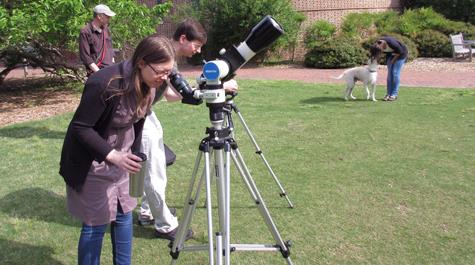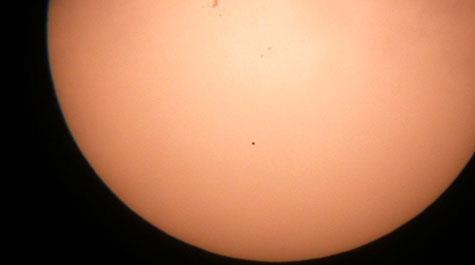It doesn't have the glamour of Venus, but the transit of Mercury is still pretty cool
Planetary transits are essentially teeny, tiny eclipses and so it was proper that a group of William & Mary faculty preparing for a 2017 solar eclipse get a start with a viewing of the transit of Mercury.
Joshua Erlich, a professor in the Department of Physics, said that eclipses are a type of transit, a phenomenon in which the moon moves between Earth and the sun. The moon is much closer than any planet, though, and during its transit throws a serious shadow on the Earth, justifying the term “eclipse.”
“The transit of Mercury occludes the sun and makes the sun appear just a little less bright overall than when the planet is not in our line of sight with the sun,” Erlich explained. “These types of periodic dimmings of stars are how experiments like the Kepler mission search for exoplanets.”
{{youtube:medium:left|QnmZ7F187jo}}
Like Erlich, Michael Gaynes is a member of the 2017 Solar Eclipse Working Group. He brought out his own two filter-equipped solar telescopes to the lawn of Small Hall on May 9, inviting passers-by to witness the transit of Mercury — the rare passage of the solar system’s innermost planet across the face of the sun.
Gaynes is a lecturer in the Department of Art and Art History, and says he isn’t an astronomer, not even an amateur. “I’m just interested,” he explained. Erlich wasn’t buying the demurral. He suggested to Gaynes that ownership of two high-quality solar telescopes constitutes prima facie evidence of an astronomer.
The Solar Eclipse Working Group is preparing for a 2017 trip to South Carolina, where the eclipse will be total. Williamsburg, and all of Virginia, will experience a partial solar eclipse. They are forming an interdisciplinary group to experience, study and celebrate the eclipse.
“It’s going to cut a swath from Oregon down to the East Coast. It’ll be a very rare solar eclipse. We’re going to do some science,” Erlich said. “We’re going to do some art.”
Mercury’s May 9 passage across the face of the sun may have made the star a little less bright, but any dimming effect was overshadowed by the clouds, which made transit-watching a hit-or-miss proposition during the seven hours and 28 minutes that Mercury traveled across the sun.
Many members of the William & Mary community found it worth their while to take a chance on the clouds to try to witness the stellar event through one of the three telescopes — the two provided by Gaynes plus another from Small Hall. Two friendly dogs in attendance, Louie and Nemo, were an additional attraction.
Joanna Schug, an assistant professor of psychology, was one of the first customers Monday morning, taking a break from William & Mary’s exam schedule. She noted that her husband is a planetary scientist at Hampton University and the transit had been a topic of conversation at home. Another viewer was Ellie Radue, who expects to receive her Ph.D. in physics in a few days.
“There were periods of high traffic absent of clouds, and I would estimate we had about 40 people or so who stopped by to view the transit,” Erlich said.
Eclipses and transits are rare. In the first place, only three heavenly bodies can position themselves between Earth and sun: the moon, Mercury and Venus. D. Chris Benner, a visiting scientist in the physics department, said that the Mercury transits are the most common. Mercury goes between the Earth and the sun every three months or so, but usually goes above or below the sun. Actual transits, in which the orbit takes Mercury across the sun relative to Earthly observers, can occur only in May or November, Benner added.
“It actually crosses the sun about 13 or 14 times per century. This is one of them,” Benner said. “The last time it did it was in 2006; the next time will be 2019. It’s a relatively rare event, but it’s not as rare as the transit of Venus.”
Transits of Venus are big deals for astronomers, most of whom live and die without experiencing one, as they come in pairs eight years apart on schedule of more than 100 years. The last transit of Venus was in 2012; the next one is in 2117.
Venus transits were valuable to scientists in times past. Benner related how measurements of the transits in the 18th and 19th centuries allowed scientists to use triangulation to calculate the size of the solar system accurately, attempts that fell short of expectations because of a phenomenon known as the "black drop" effect.
Mercury transits may not have the rarity of Venus, nor do they have a similar place in scientific history, but the May 9 event was interesting enough to bring a steady stream of people to witness the phenomenon. It served, Erlich notes, as an excellent warm-up event for the 2017 Solar Eclipse Working Group. Skip to main content
Skip to main content


